I guess it’s Citroen week here at Barn Finds. While it is a very storied brand, not too many find their way to our discovery list. Yesterday, we covered this outrageous 1964 DS that is now Corvette powered and today it is a 1969 “Ami”, a model that I don’t recall ever seeing in spite of production running through 1978 and my numerous trips to France. That being the case, let’s investigate. This Citroen is located in Simi Valley, California and is available, here on Facebook Marketplace for $6,950.
Produced between 1961 and 1978, the front-wheel-drive Citroen Ami was offered in four-door notchback (Model 6) and four-door fastback (Model 8) body styles, a five-door station wagon, such as this example and known as a “Break”, and a two-door van. The seller refers to this Ami as a “6” but it’s a 6 Break model (apparently there was an “8” Break too). While I’m not familiar with this model, perhaps I should be, 1.8M were sold over its eighteen-year life span, about 102K per year so that’s a noteworthy volume.
According to the seller, this Ami is a non-runner by virtue of an electrical problem that, “can be fixed very easily“. Hmmm, if that’s the case, why not proceed? I can state from experience a runner is a lot easier to sell than a non-runner. Motivation is courtesy of a 32 HP, 602 CC, horizontally opposed, two-cylinder engine which is attached to a four-speed manual transaxle. It’s an odd-looking engine, to say the least. Obviously, the air cleaner has been removed, whether everything else is under the hood as it should be will require further inquiry.
The exterior is, well, awkward in design. It would seem that visibility was front and center in the designer’s mind and it appears that the objective was accomplished. The finish still has some shine to it and the chrome and trim seem to be as originally intended – I really like the hoop overriders protecting the rear taillights. As for body panel alignment, it’s tough to tell if there really is a problem with the rear passenger door and the hood, or maybe they’re just ajar. Another observation is that while the rear end is bumper protected, the front end is pretty well unguarded – perhaps the bumper is missing? That said, the grille still seems to be reasonably straight.
The interior possesses a similar quirky dash and steering wheel as does the DS – it is unique to Citroen, that’s for sure. The red fabric seat upholstery appears to have held up well though there is some typical wear and discoloration; all-in-all, it’s a decent environment. The rear cargo compartment is carpeted in gray which appears to match the carpet in the passenger compartment but it is indicative of little or careful use – no signs of wear. The way back looks to be pretty commodious; if the rear seat folds down, it would be so much more so.
Considering the production numbers, the Ami is not a rare automobile but location matters, and having one turn up here in the U.S. is not going to be an everyday event. Finding a Citroen for sale is no big deal, DS’s and 2CV’s abound, but an Ami? not so much. And that leads, as it usually does, to a question of price. I’ll throw it out to you, what do you think, almost $7 large for this rather “unique” automobile? If you were to own it you’d probably have the only one in town and be a one-off at your local car show. But is it worth the price for that distinction?

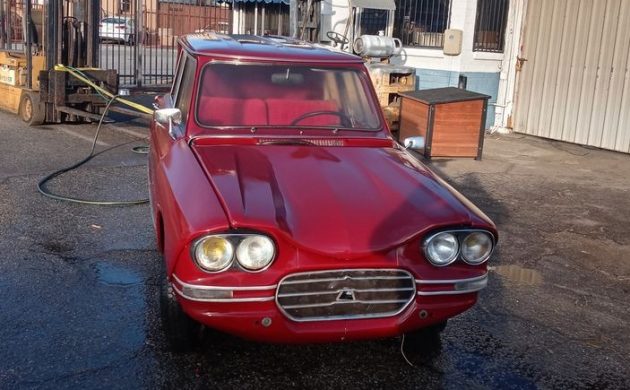
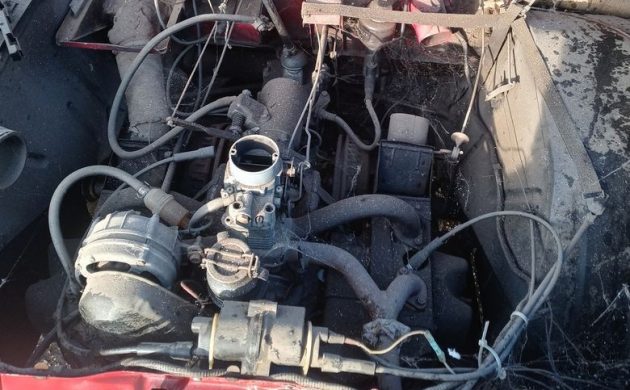
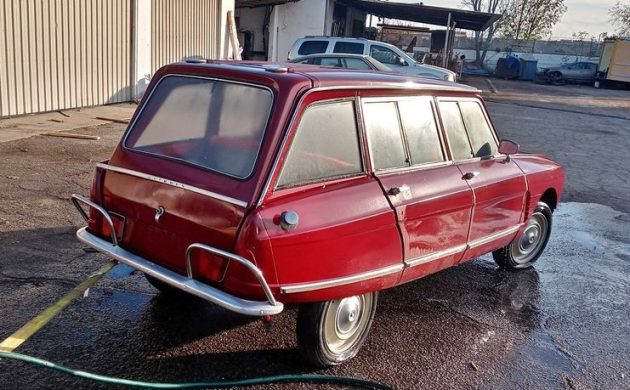
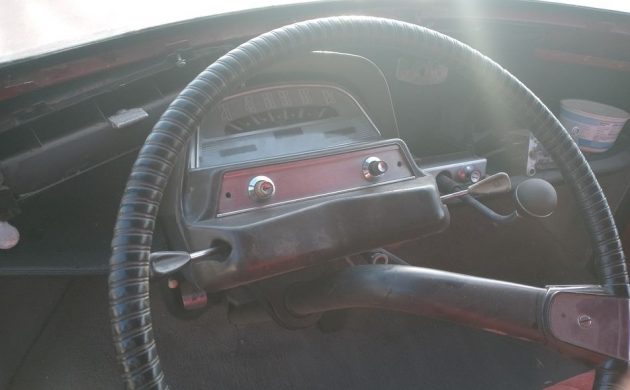
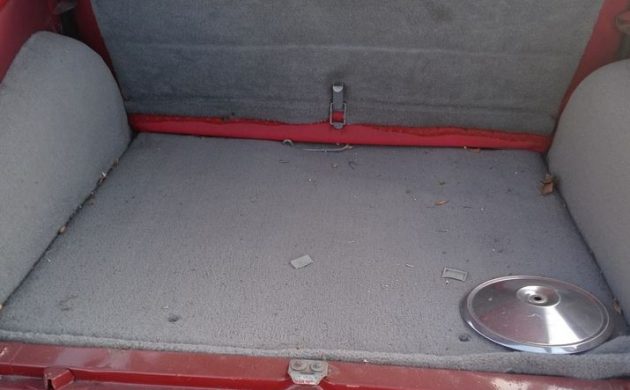


How Gallicly Galling. It’s as if the one goal of the design was to thumb their noses at conventionality.
I live in a rural area where most of the roads are gravel and rough. This car excels on road surfaces like this with its soft sprung ample wheel travel suspension. Love the quirkiness if the Citroen cars. Would much rather drive a quirky car rather than a mainstream one. Life is boring enough with today’s choices. I prefer the sedan over the break though.
They say Wagon in the US, not Break …
Again……”Once you own a French car, nothing worse can happen to you”.
Even so, I’d buy this car and park it next to the resto-modded GTO/Camaro/Mustang/57 Chevy whatever just to piss ’em off! Love it.
I think you’d attract more attention and inquiries about this than about the GTO/Camaro/etc., too.
It’s amazing. From the land that gave us the beauty of Brigitte Bardot, Catherine Deneuve, Eva Green and Isabelle Adjani come designs like this…😳
But you’ve a point, Rex-parking this next to someones Citroen-Maserati SM or Bugatti Chiron at a day on the green!
I’m confused by those headlights. (Most?) French home-market Amis had single square Marchal composite units. Those offered new in the US (yes, they were, at least earlier in the ’60s) had quad round sealed beams in bezels just like this car’s. And here there’s quad round headlights with distinctly French yellow bulbs.
The square lamps were not approved in the US, just like with the DS and SM (+many other Euro cars so equipped) it was illegal to run lenses ahead of the headlights. Up to a certain date the only DOT approved headlights were circular sealed-beams.
In Europe headlights would commonly be of the H4 replacable bulb design and installing yellow bulbs or even yellow glass headlights was extremely common due to better visibilty under foggy conditions
A quick image search shows that models designated 1969 Citroen Ami 6 Club Break usually have quad round lights in continental Europe. That’s why this one has yellow French lights instead of DOT sealed beams.
As for why any variant of a Euro model would be equipped with quad rounds when other variants of the same model had composite units, quad rounds were generally regarded as providing superior illumination — round lamps having simpler optics easier to optimize separately for high and low beams — so uprated submodels/trim levels would sometimes have quad rounds specified as a feature.
I was curious so I did some research on the issue with yellow headlights because as a kid I clearly remember whenever I saw tourists with the ‘F’ letter code on the trunk lid the car would have either yellow bulbs or lenses. Turns out they were no less than required BY LAW in France 1936-1993!
https://www.connexionfrance.com/Mag/French-Facts/Military-thinking-behind-yellow-headlights
The color is called ‘selective yellow’ and there are numerous thoughts/rumors on why it was introduced and even held onto for so many years. However it is a well-known fact that yellow light will increase contrast
They yellow lights were required. The supposed benefit is for vision in fog.
They were abandoned to conform with “Europe” norms
Normally, I’d take a wagon over a sedan but, in this case I’d much perfer the sedan Alphasud pictured. If you’re going to go quirky you might as well go all the way. I like both of them. I just think that the sedan takes quirky to the next level.
Definitely missing the front bumper
https://www.pinterest.ca/pin/128211920616885538/
Quote from Click ‘n Clack the Tappet brothers: ” . . . . . . . the French copy no one & no one copies the French . . . . . . . .” !
Well said,sir. Those two are truly missed!
I love this thing! If I had the ability this would be in a garage next to a VW type 3 squareback and possibly a Reliant Robin.
I dig a quirky wagon. and one that shares some obvious design similarities with a 2CV is right up there.
I’m a glutton for punishment.
he wants runner money for a non runner. $7K seems a bit optimistic for a French car that was never quite supported in the US (not like the DS).
No ‘ami’ lost here.
The AMI (Friend) 8 was the next model iteration which visually not that different was a big upgrade in power to 602cc would do 110 KPH (70 MPH) “Pied a Planche” – foot to the floor which was how Citroen advertised it and was also given front disc brakes for reference I sold a nicely running one on BAT last year for $18k
“Pied au plancher”, not “pied à planche”. Congrats, though, for this typical french expression.
602 Cm3 is very, very small (even in France) to move a car with 5 passengers, but it did. 602 Cm3 (cubic system) would be 36 Cubic Inches (yes, 36). Quite a small block, in the US standards.
Nice car, but needs to be running for that price, can´t be anything difficult because of what it is. It is basically a 2CV mechanically, so spares are not a problem.
I´ve never seen those lights in Europe, but CJinSD is quite right, so I guess that is the “Club” element, no doubt a more expensive option.. The square Ami lights were used on the Lancia Fulvia Sport by Zagato. And French lights were yellow because they were supposed to dazzle less. Which they did, by being less bright…….
First, there was the Ami 6, available in sedan and “break” configurations. “Break” means station wagon in French, and is the origin of the term “shooting break.”
This was followed by the Ami 8, with similar choices.
Roomy, easy to maintain, and comfortable. Based on the 2CV platform, but modernized for the 1960s.
The styling is bizzare, but it was done by Bertoni, before he changed the spelling of his name (and stopped the hallucinogens?)
Bertoni and Bertone were different designers; the former was Flaminio, and the latter were Giovanni and his son Giuseppe “Nuccio”.
Fun Fact: A two-door fastback Ami 8 Coupé was offerred with a Wankel engine. Knows as the Citroen M35. Only 267 were produced.
Was that the car that Citroen took back due to reliability issues? I know a few still remained in owners hands if that was the model I’m thinking about.
That was the GS Birotor. Only about 800 were produced. Citroen bought them back and crushed them. There are a few still around. The Lane has one. The Ami based M35 was a prototype and I don’t think was ever on sale to the public.
AMI 6 – Bertoni but credit for the AMI 8 I believe goes to Robert Opron who also penned the AMI Rotary conceptcar, the Citroen SM and Renault Turbo amonsgt others. Cheers Retrogreg
French designer Bertoni and Italian designer Bertone are two distict different people.
This is not 1969
Ami 6 Break. Very popular among the Citroen fans all over the planet.On this one it is missing the front bumper. The model also was available with regular stile headlights and small round tail lights. I personally own a Deux Chevaux Vapeur aka the 2cv and its the most comfortable car ever built. The only thing wrong with these old Citroens is that they are no longer produced like these ugly plastic new “cars” nowadays. So it is very hard to find a solid one or start restoring one. Mine costed 10 000 euros to have it restored to mint condition.
This has an electrical problem? well first off, the right spark plug wire is not connected to the plug! So while it could be that simple, methinks NOT!
When faced with a non-running car, where an engine overhaul could be$3 – $5k, The owner is asking twice what it’s current value is, as a non-running car. And of course with a non-running car, it might need suspension/steering, total brakes, clutch, gearbox overhaul, major wiring harness work, plus a small myriad of little things that also add up to a lot of shipping costs from Europe.
But having an owner claim it’s only a little electrical problem, but the car will not even start, and half the plug wires are not connected, that’s a red flag!